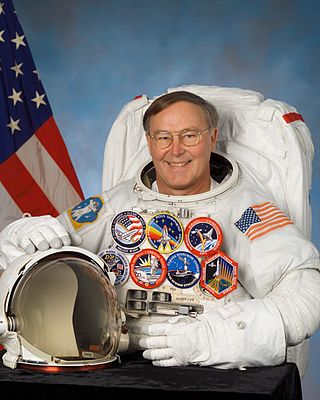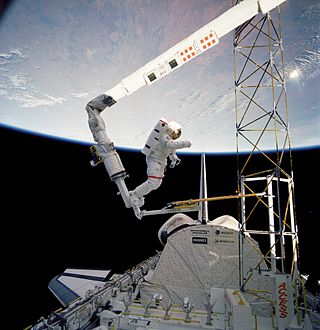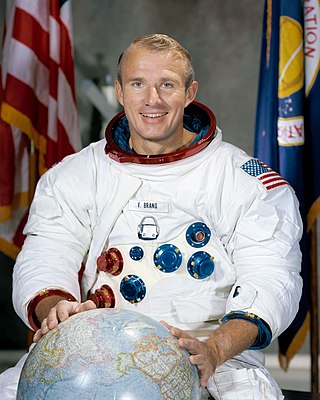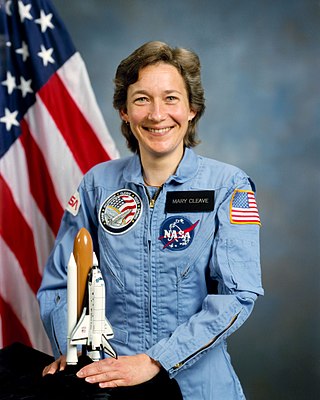
The Space Shuttle is a retired, partially reusable low Earth orbital spacecraft system operated from 1981 to 2011 by the U.S. National Aeronautics and Space Administration (NASA) as part of the Space Shuttle program. Its official program name was Space Transportation System (STS), taken from a 1969 plan for a system of reusable spacecraft where it was the only item funded for development.

Jerry Lynn Ross is a retired United States Air Force officer, engineer, and a former NASA astronaut. Ross is a veteran of 7 Space Shuttle missions, making him the joint record holder for most spaceflights.

STS-41-D was the 12th flight of NASA's Space Shuttle program, and the first mission of Space Shuttle Discovery. It was launched from Kennedy Space Center, Florida, on August 30, 1984, and landed at Edwards Air Force Base, California, on September 5, 1984. Three commercial communications satellites were deployed into orbit during the six-day mission, and a number of scientific experiments were conducted, including a prototype extendable solar array that would eventually form the basis of the main solar arrays on the International Space Station (ISS).

STS-61-A was the 22nd mission of NASA's Space Shuttle program. It was a scientific Spacelab mission, funded and directed by West Germany – hence the non-NASA designation of D-1. STS-61-A was the ninth and last successful flight of Space Shuttle Challenger before the disaster. STS-61-A holds the current record for the largest crew—eight people—aboard any single spacecraft for the entire period from launch to landing.

STS-61-B was the 23rd NASA Space Shuttle mission, and its second using Space Shuttle Atlantis. The shuttle was launched from Kennedy Space Center, Florida, on November 26, 1985. During STS-61-B, the shuttle crew deployed three communications satellites, and tested techniques of constructing structures in orbit. Atlantis landed at Edwards Air Force Base, California, at 16:33:49 EST on December 3, 1985, after 6 days, 21 hours, 4 minutes, and 49 seconds in orbit.

STS-61-C was the 24th mission of NASA's Space Shuttle program, and the seventh mission of Space Shuttle Columbia. It was the first time that Columbia, the first space-rated Space Shuttle orbiter to be constructed, had flown since STS-9. The mission launched from Florida's Kennedy Space Center on January 12, 1986, and landed six days later on January 18, 1986. STS-61-C's seven-person crew included the first Costa Rican-born astronaut, Franklin Chang-Díaz, and 2 future Administrators of NASA: the second African-American shuttle pilot, Charles Bolden, and the second sitting politician to fly in space, Representative Bill Nelson (D-FL). It was the last shuttle mission before the Space Shuttle Challenger disaster, which occurred ten days after STS-61-C's landing.

Henry Warren Hartsfield Jr. was a United States Air Force Colonel and NASA astronaut who logged over 480 hours in space. He was inducted into the United States Astronaut Hall of Fame in 2006.

Vance DeVoe Brand is an American naval officer, aviator, aeronautical engineer, test pilot, and NASA astronaut. He served as command module pilot during the first U.S.-Soviet joint spaceflight in 1975, and as commander of three Space Shuttle missions.

STS-57 was a NASA Space Shuttle-Spacehab mission of Space ShuttleEndeavour that launched June 21, 1993, from Kennedy Space Center, Florida.

STS-85 was a Space Shuttle Discovery mission to perform multiple space science packages. It was launched from Kennedy Space Center, Florida, on 7 August 1997. A major experiment was the CRISTA-SPAS free-flyer which had various telescopes on board.

STS-72 was a Space Shuttle Endeavour mission to capture and return to Earth a Japanese microgravity research spacecraft known as Space Flyer Unit (SFU). The mission launched from Kennedy Space Center, Florida on 11 January 1996.

Michael Allen Baker is a retired captain in the United States Navy, former NASA astronaut, and the International Space Station Program Manager for International and Crew Operations, at NASA's Johnson Space Center. He is responsible for the coordination of program operations, integration and flight crew training and support activities with the International Partners.

Mary Louise Cleave was an American engineer and NASA astronaut. She also served from 2005 to 2007 as NASA Associate Administrator for the Science Mission Directorate.

George David Low was an American aerospace executive and a NASA astronaut. With undergraduate degrees in physics and mechanical engineering and a master's degree in aeronautics and astronautics, he worked in the Jet Propulsion Laboratory (JPL) at the California Institute of Technology in the early 80's, before being picked as an astronaut candidate by NASA in 1984. In addition to holding some technical assignments, he logged more than 700 hours in space, before he left NASA in 1996 to pursue a career in the private sector. He was the son of George M. Low, the manager of the Apollo Spacecraft Program Office, and later, the 14th president of Rensselaer Polytechnic Institute.

James Shelton Voss is a retired United States Army colonel and NASA astronaut. During his time with NASA, Voss flew in space five times on board the Space Shuttle and International Space Station. He also served as deputy of Flight Operations for the Space Station Program Mission Integration and Operations Office. While participating in ISS Expedition 2, he and Susan Helms conducted an 8-hour and 56 minute spacewalk, the longest to date.
Lockheed Martin Space is one of the four major business divisions of Lockheed Martin. It has its headquarters in Littleton, Colorado, with additional sites in Valley Forge, Pennsylvania; Sunnyvale, California; Santa Cruz, California; Huntsville, Alabama; and elsewhere in the United States and United Kingdom. The division currently employs about 20,000 people, and its most notable products are commercial and military satellites, space probes, missile defense systems, NASA's Orion spacecraft, and the Space Shuttle external tank.

Stephanie Diana Wilson is an American engineer and a NASA astronaut. She flew to space onboard three Space Shuttle missions, and is the second African American woman to go into space, after Mae Jemison. As of 2022, her 42 days in space are the second most of any female African American astronaut, having been surpassed by Jessica Watkins in 2022, however in 2024 she was assigned to the Crew-9 mission during which she should retake the lead.

A payload specialist (PS) was an individual selected and trained by commercial or research organizations for flights of a specific payload on a NASA Space Shuttle mission. People assigned as payload specialists included individuals selected by the research community, a company or consortium flying a commercial payload aboard the spacecraft, and non-NASA astronauts designated by international partners.
Astronauts hold a variety of ranks and positions. Each of these roles carries responsibilities that are essential to the operation of a spacecraft. A spacecraft's cockpit, filled with sophisticated equipment, requires skills differing from those used to manage the scientific equipment on board, and so on.

NASA Astronaut Group 9 was a group of 19 NASA astronauts announced on May 29, 1980, and completed their training by 1981. This group was selected to supplement the 35 astronauts that had been selected in 1978, and marked the first time that non-Americans were trained as mission specialists with the selections of ESA astronauts Claude Nicollier and Wubbo Ockels. In keeping with the previous group, astronaut candidates were divided into pilots and mission specialists, with eight pilots, eleven mission specialists, and two international mission specialists within the group.
























